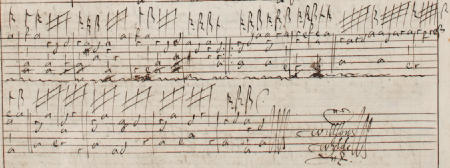Wilson's Wilde and Wilson's Wylde (Anonymous)
![]() Wilson's Wilde is a lute piece of unknown
authorship often misattributed to John Dowland, likely because
the best-known version originates from the
so-called Dowland Lute Book, MS V.b.280 (olim 1610.1),
in which it is titled Willsons Wilde. It
is doubtful the Dowland Lute Book
belonged to John Dowland or his family, but his autograph
appears next to a number of his compositions in the book. John
Johnson's signature also appears next to other pieces in the
book. But no such attribution accompanies Wilson's
Wilde. The piece also appears in other lute books,
including one of the Holmes books—MS Dd.2.11, which I used
as the source
for Orlando
Sleepeth—where it is titled Willsons
Wylde. The version in the Holmes book is shorter,
but employs more interesting harmony. Therefore, I have
transcribed both versions from the original tablature, using the
Folger Shakespeare Library's MS V.b.280 (olim 1610.1) and the
Cambridge University Digital Library's MS Dd.2.11.
Wilson's Wilde is a lute piece of unknown
authorship often misattributed to John Dowland, likely because
the best-known version originates from the
so-called Dowland Lute Book, MS V.b.280 (olim 1610.1),
in which it is titled Willsons Wilde. It
is doubtful the Dowland Lute Book
belonged to John Dowland or his family, but his autograph
appears next to a number of his compositions in the book. John
Johnson's signature also appears next to other pieces in the
book. But no such attribution accompanies Wilson's
Wilde. The piece also appears in other lute books,
including one of the Holmes books—MS Dd.2.11, which I used
as the source
for Orlando
Sleepeth—where it is titled Willsons
Wylde. The version in the Holmes book is shorter,
but employs more interesting harmony. Therefore, I have
transcribed both versions from the original tablature, using the
Folger Shakespeare Library's MS V.b.280 (olim 1610.1) and the
Cambridge University Digital Library's MS Dd.2.11.
For guidance about playing music for the six-course Renaissance lute on the guitar, see the discussion at Orlando Sleepeth. I have transcribed the music so as not to require retuning the third string. That has necessitated playing measures 8 and 9 of Wilson's Wilde in the fourth position to enable the D to sound for its full duration. Keeping the piece in the first position at that point would have required truncating the note by a fourth of its duration at the playing of the F♯. I have placed the measure 15 low E in parentheses because it does not occur in the source tablature. It is my editorial addition to correct what appears to have been an accidental omission in the hand-copied tablature.
 |
The double bar lines after the first repeat do not have dots, making it unclear if the contained measures should be repeated.
In Wilson's Wylde the repeat bar lines after measure 5 are my interpretation of the intent of the double bar lines appearing in the source tablature. The first repeated section includes dots in the double bar line, but subsequent sections do not include dots (see Figure 1). I believe the intent was for those double bar lines to be repeat bar lines because the piece does not sound right played to the end without any repeats. That said, the equivalent of measures 6–9 in Wilson's Wilde (measures 10–13) are played as a single repeated group instead of two repeated groups. You may make your own determination as to how the piece should be played. Given the richer harmony in Wilson's Wylde, you may also consider combining the two pieces, perhaps playing them in sequence to make the music last longer.
| Revision History | ||
|---|---|---|
| 2018-05-13 | ||
|
In Wilson's Wilde, eliminated half-barre from measures 8 and 9, playing an open second string instead while in fourth position, and moving back to first position, playing an open fifth string. | ||
| 2018-05-12 | ||
|
First draft. | ||
